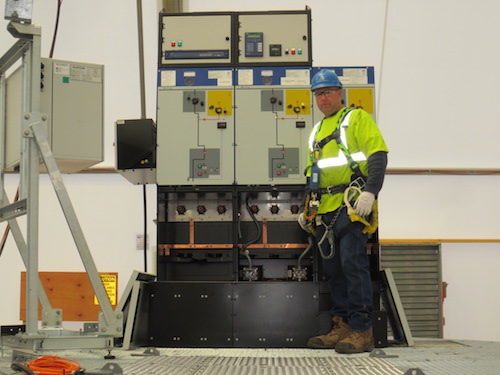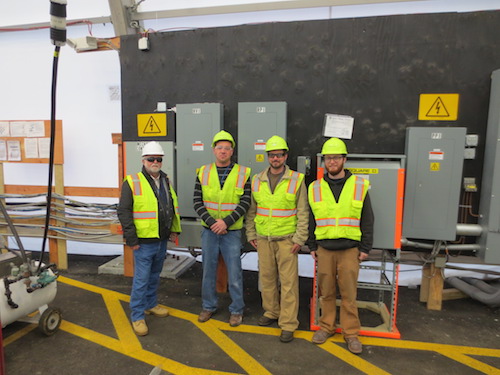Three miles off the coast of Block Island – and 16 miles off the Rhode Island mainland -- will stand the first offshore wind farm in U.S. waters, another sign that wind energy is making inroads in North America.

|
| Chris Wilson, a Local 99 member and employee of Audet & Sons, stands in front of a medium voltage switch gear at the Port or Providence.
|
It has added significance for Providence, R.I., Local 99. The construction of the five-turbine farm is a chance to be a part of history and also put its members in line for good-paying jobs now and in the future.
“We’re at the dawn of a new source of energy. ...Being on the ground of this initial project will hopefully give us a leg up on the next project,” Business Manager Michael Daley said.
Daley said about 50 wiremen from Local 99 are expected to work on the Block Island project, most of them at the Port of Providence, where Local 99 members helped build a temporary construction facility last winter.
They have been replaced by crews assembling the five turbines and cables to support them. The turbines will be put on barges and transported to the Block Island site sometime this summer. Deepwater Wind, the windfarm owner, expects it to be generating power later this year.
It hasn’t been the easiest work. Heavy rains during the winter slowed construction of the temporary facility. So did the unexpected discovery of methane gas. Most of the parts were built overseas and French- and Spanish-speaking workers also are on the jobsite, leading to some communication difficulties.
“I’ve never been a part of anything else like it,” said Local 99 member Jack McGee, who interrupted his retirement to serve as construction manager at the temporary facility for IBEW signatory contractor Aladdin Electric.
But it’s all been worth it.
“There’s going to be a lot of new construction because of this and we want to be part of it,” said Local 99 member Jeff Audet, co-owner of E.W. Audet & Sons, who heads a crew of IBEW workers assembling the turbines.
New Opportunities
There are thousands of wind farms off the coasts of Europe, China and Japan. But in the United States, most have been built on the open plains of the Midwest and West. States getting the largest percentage of their energy from wind are Iowa, South Dakota, Kansas, Oklahoma and North Dakota, according to the American Wind Energy Association.
That availability of land has discouraged the building of offshore facilities. So have other factors. Some owners of oceanfront property have worked to squash them, including the highly-publicized Cape Wind project proposed for Nantucket Sound off the coast of Massachusetts’s Cape Cod.
But Rhode Island officials welcomed the Block Island project. They see it as a way to boost the state’s economy and get a jump on an emerging, clean-energy technology ahead of other coastal states. They worked in concert with Providence-based Deepwater Wind to pick the site.
The IBEW was among several trade unions that lobbied Rhode Island officials to ensure it would be built and Deepwater Wind officials turned to them when construction began.
“They bring with them the unique skills and experience we need to complete this work and we’re pleased that IBEW members are part of the world-class team we’ve assembled to build this project,” Deepwater Chief Executive Officer Jeff Grybowski said.
Located in a spot with strong winds, the project is expected to significantly lower energy costs on the island, which isn’t connected to the mainland grid and has to import one million gallons of diesel fuel every year.
Daley expects it to lead to bigger and better things for Local 99 members. They will have permanent positions at substations on the island and in Narragansett, R.I., he said. Deepwater Wind also has plans to build a 200-turbine farm in federal waters off the coasts of Rhode Island and Massachusetts, with work starting sometime next year. Local 99’s signatory contractors are expected to be involved in working on that, too.
“We at Deepwater Wind felt it was important to start out small, with a demonstration-sized project like this one, and Rhode Island is the perfect place to launch this industry,” Grybowski said. “We’re confident that the Block Island Wind Farm is just the start of something bigger.”
Site Challenges

|
| Local 99 member Jack McGree, left, came out of retirement to serve as project manager for Aladdin Electric during the building of a temporary construction facility. Other Local 99 members on the project, from left, included Jonathan McKeen, Matt Lattinville and Jon MacDonald.
|
For members like McGee and others at Aladdin Electric, the job is finished. He and his crew completed work on the temporary construction facility on Feb. 1.
Temperatures were mild by New England winter standards, but there was more rain than usual, he said. Workers preparing to pour the concrete base found methane just beneath the ground’s surface. That delayed work for six weeks while a protective barrier was built.
“That created a time problem,” McGee said. “Then we had to monitor the methane and had to put in a control system.”
The situation also forced crew members to deal with standing water. It couldn’t seep into the ground during and after rainstorms and had to be removed manually.
“When we had an open pit, all the water would run into that opening,” McGee said.
For others like Audet, the work is ongoing. But as he pointed out, IBEW members are used to taking on difficult jobs.
“Our guys know how to put things together,” Audet said. “With the knowledge they’ve gained in the past on other construction sites, they can adapt and make it happen.
“Most of my guys have been with me for a long time, for more than 10 years. I have a lot of trust in them and they know what to do. If they don’t, they know the right questions to ask.”
Daley said he is hopeful some Local 99 members will be involved in construction at the on-water site near Block Island.
That remains uncertain. But no matter the future in wind energy in and around Rhode Island, he’s confident Local 99 will have a place in it. Daley recently attended a conference in Boston for companies pursuing wind-energy products. It convinced him more than ever of the importance of Local 99 getting involved.
Among the companies on hand was GE, which has installed more than 30,000 wind turbines on land, but is moving into the offshore market. GE’s renewable energy division is installing electrical and mechanical components in the Block Island project’s five turbines.
“We’re trying to get out the message that green energy is good,” Daley said. “There will always be fossil fuels. But the less reliant we can be on those, the better off we’ll be. That’s the message we’re trying to promote.”